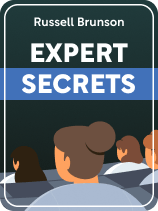

This article is an excerpt from the Shortform book guide to "Expert Secrets" by Russell Brunson. Shortform has the world's best summaries and analyses of books you should be reading.
Like this article? Sign up for a free trial here.
What makes something a movement? What if you could create a movement instead of just running a business?
Imagine you have a product or service that can change people’s lives—one that can help them reach their most ambitious goals financially or personally. Russell Brunson says you should look at your product or service as merely a tool that supports something much greater—a movement.
Read more to learn how to create a movement and not just a business.
How to Create a Movement
Brunson writes that, to launch a business that changes people’s lives—and also makes you lots of money—you’ll need to launch a movement, not just a product. The movement is what will inspire people to adopt your ideas and become lifelong customers. Your product is merely the tool to support the movement.
He writes that every successful movement has three elements:
- A charismatic leader
- An inspiring vision
- A new opportunity
We’ll examine each of these three elements and Brunson’s advice on how to create a movement with them.
| Why Are Movements Compelling? Movements motivate people because they combine our instinct to be part of a group and our desire to be part of a greater purpose. Brunson’s three essential elements of movements summarize many of the themes that others name as basic characteristics of movements: Movements typically have a leader, a collective identity (aligning with Brunson’s vision), and a common cause or vision (aligning with his new opportunity). Some argue, though, that movements, particularly social movements, often don’t have a single leader but instead are most effective as grassroots collections of action. However, few dispute that movements with charismatic leaders can get more traction because recognizable leaders can draw public attention to their cause. These are the movements Brunson models his advice after. Brunson’s advice to focus on starting a movement for your company rather than a social movement aligns with a marketing approach called movement marketing, which encourages business leaders to focus not on their specific service or product but instead on a cultural or social change. In this approach, your product becomes a tool for solving a larger, society-wide problem (aligning with Brunson’s advice to see your product as a tool). For example, your product might be affordable eyewear, but your focus will be on the larger problem of people who need glasses but are unable to afford them—a problem for many lower-income people. By focusing on this problem, you can position your company as the standard-bearer for a better world, linking your product positively in consumers’ minds. |
Become a Charismatic Leader
Brunson writes that people may check out your business because they’re curious about your product, but it’s your personality and their relationship with you that will convince them to stay.
Therefore, he advises that you create an attractive public personality and then build a relationship with your customers—specifically, one in which you act as an expert who can guide them to achieve their goals.
Inspire Your Followers
Brunson notes that leaders of movements are inspirational. Thus, to attract people to you and your message, aim to inspire them: Encourage them to dream big and aim for high goals, and calm their fears by helping them see hope that they can achieve the goals they want.
Also, make them feel you’re on their side against their enemies. Show them that you care about their struggles, can identify with what they’re going through, and want to help them vanquish their enemies. Help them understand that they’re not responsible for their past failures but instead, the previous systems and tools they used were flawed. This will create an “us versus them” mentality through which they’ll see themselves as part of your team, and which will foster loyalty to you.
Become an Expert
Your customers will stay loyal to you and your company if they see you as an expert who can guide them toward their goals. To become an expert they’ll trust, learn as much as you can about your field. Read, go to seminars and events, and even start a show or podcast, which will enable you to interview experts you otherwise wouldn’t have access to.
Once you’ve developed expertise, it’s time to get people to see you as the expert you’ve become. To do so, Brunson advises that you share your message consistently and frequently. Publish daily for at least a year. This will help you develop a unique voice that will set you apart from your competitors.
It will also ensure you work through the initial phase of putting your message into the world—the phase when you haven’t fully developed your voice and your posts aren’t high quality yet. He writes that everyone goes through this low-quality phase, but not to worry: In the beginning, you won’t have a large audience, so few will notice. By the time you’ve attracted a sizable audience, you’ll have developed an effective voice and a strong message.
What Should You Publish?
Brunson notes that the idea of publishing every day can be intimidating because people often don’t think they can come up with content daily. He offers some tips to get past this difficulty.
Make it easy: Instead of creating lengthy, original content full of teaching or marketing materials, simply document your thoughts: things that are important to you, your journey, your process, what you’ve learned, and so on. This is still original content, but it’s easy to come up with.
Be a little strange: Don’t shy away from saying things that are slightly unusual or controversial. No one gets rich by being ordinary because run-of-the-mill ideas don’t attract attention and people won’t pay for them. Brunson notes that even if some people don’t like your message because it pushes boundaries, that can work in your favor: When people are vocal about their dislike, they can bring even more attention to you. However, he cautions that your message shouldn’t be too off-the-wall because, if you appeal to a too-narrow niche of consumers, the mainstream will view you as too weird and won’t pay attention. He advises that you find the sweet spot between “strange enough” but “not too strange.”
Offer a Vision of a New Identity
Brunson writes that to create a movement that attracts people, you have to offer a vision of an idealistic future in which your customers are better versions of themselves. This vision should be one of both achievement and transformation, and Brunson emphasizes that it should be more than a mere improvement plan—it should prompt your audience to envision a completely new identity for themselves. For example, instead of selling an exercise plan that merely shows people how to do better sit-ups, help your customers envision themselves as masters of their health and bodies. This will engage them emotionally and turn them into lifelong customers.
To encourage your customers to envision this new identity, Brunson recommends that you create a manifesto stating your company’s vision in an inspiring way and helping your audience see themselves as part of a group with special characteristics. One way you can do this is to name the kind of customer who uses your product and describe them—for example, for Brunson’s company, ClickFunnels, his manifesto said, “A Funnel Hacker is a new breed of entrepreneur…” and it went on to describe “funnel hackers” as people who “define their own identity” and “create their own luck.”
You can take these statements a step further to foster a sense of belonging by creating swag, such as t-shirts or mugs, that sport “I am” statements mirroring your manifesto (such as, “I am a Funnel Hacker” or “I create my own luck”).
| The Link Between Identity and Behavior Brunson is not the first to observe that the best way to change your behavior is to adopt a new identity. In Atomic Habits, James Clear agrees, writing that if you want to change your behavior, you should focus on who you want to become rather than what you want to achieve. Clear goes further to note that behavior (specifically, habits) and identity are interwoven: As much as a new identity inspires new habits, those new habits will solidify your new identity (if you run daily, you’re a runner). Brunson focuses more exclusively on the line of causation from identity to behavior, but we might infer that he’d agree that behavioral changes resulting from a new identity serve to strengthen that new identity. His advice to create swag for your customer is based on a similar underlying principle, in that both habits and swag serve as routine, daily reminders of the new identity a person has chosen. |
Offer a New Opportunity
The third element of a movement is a new opportunity, which is the product or service you’ll offer to solve your customers’ problems. Brunson writes that you must ensure this idea isn’t merely an improvement on an existing product, but instead is something entirely new and original—this is how you’ll create and dominate an original category.
Brunson argues that unless your product creates a new category, you won’t create a movement that engages people and creates fans. He notes that Steve Jobs didn’t just offer a faster or bigger CD player, but instead created a new category—a way to carry your entire music collection in your pocket (with an iPod). If he’d merely developed an improved music player, he wouldn’t have inspired the following he attracted.
| Possible Limits of New Markets and New Identities In many aspects of Brunson’s advice, he emphasizes the need to set your company apart from competitors in any way possible, and as such, his advice to create a completely new category with your opportunity aligns with his advice to help your customers create a completely new identity. It’s worth noting that Steve Jobs’s product creations not only created a new category but helped his customers envision themselves as part of a new identity—one in which they saw themselves as Apple users who feel good about themselves and their choices under this identity. However, while Brunson advises that you use your innovation to create a new market, not all business experts agree creating a new market is necessary—some argue that there’s enough unmet demand within existing markets to ensure success for your innovation. In Competing Against Luck, Clayton Christensen writes that to come up with an idea that can lead you to success in any market, look for ways people creatively tackle tasks for which there’s no sufficient solution yet. These DIY solutions can reveal problems for which there’s a ready customer base, and even if this isn’t in a unique field, any innovation you develop to meet this customer need can bring you success |
Structure Your Idea in a Framework
Brunson writes that, to be successful, you can’t just sell a product. Instead, you must sell a product within a framework—a set of predictable steps your customers can follow to achieve their goals using your product. This framework will be so integral to your product that it will be inseparable from it—without the framework guiding customers, your product won’t be nearly as powerful and your customers won’t be as interested.
He cites his own marketing tool as an example. His company, ClickFunnels, sells software to help online businesses create sales funnels that upsell additional products. What makes the software stand out from competitors are the frameworks—predictable, repeatable steps—helping customers incorporate this software into their businesses.
To develop frameworks for your product or service, first research existing successful frameworks. Find successful people and find out what they did to reach success. Often, they’ll talk freely about their process in interviews, podcasts, live events, and so on.
Then, take the elements of those processes that appeal to you and incorporate them into new frameworks designed for your specific goal. Test your framework on yourself and make adjustments as needed. Name it, as this makes it easy for people to recognize and remember it.
Finally, test your framework on other people to ensure it works for them, too. Initially, don’t charge people to use your framework—at this point, your goal isn’t to make money but instead, to perfect your framework, get experience, and build a track record that shows your framework is effective.
| Using Frameworks for Frameworks Businesses have been using frameworks for years to both develop and execute strategy—by following an established system of rules, they can more easily make decisions or carry out business processes. Brunson’s innovation is to apply frameworks to customer experiences rather than business processes. The underlying principle is the same, though: By following a predictable set of steps, both customers and businesses can achieve their goals faster than if they were figuring out how to use a product each time they worked with it. In the same way that Brunson says that when creating a framework, you should adopt elements from other successful frameworks, business consultants also recommend that companies looking to adopt frameworks examine the multitude already in existence. Whether you’re looking to design new products, analyze your industry’s strengths and weaknesses, become more customer-focused, or manage complex projects, a framework likely exists for a similar problem. Successful frameworks are often examined in the same forums Brunson recommends you look into—blogs, websites, and podcasts frequently post information to help companies strategize. In fact, frameworks exist for each step of Brunson’s advice on how to create frameworks. There are frameworks that can help you research other companies’ frameworks, test your framework, and even name your framework. Ultimately, no matter what you’re trying to accomplish or what step you’re on, you can streamline your process by examining how others have approached a similar challenge. |

———End of Preview———
Like what you just read? Read the rest of the world's best book summary and analysis of Russell Brunson's "Expert Secrets" at Shortform.
Here's what you'll find in our full Expert Secrets summary:
- A how-to guide for creating excitement about your business ideas
- How to tap into your audience’s emotions to create loyal customers
- Tips for identifying and targeting your core market






